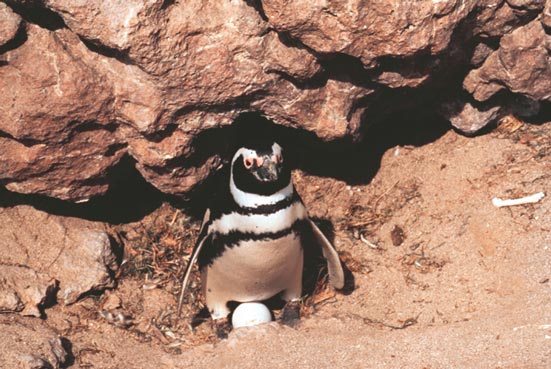South Beach Diet
By Frank Diller
Mollusk shells provide penguin mothers with the calcium that makes up one-third of the average eggshell
Mollusk shells provide penguin mothers with the calcium that makes up one-third of the average eggshell

DOI: 10.1511/2004.48.0
If you want to make a penguin, you've got to break a few eggs. But in Punta Tombo, Argentina, the largest Magellanic penguin (Spheniscus magellanicus) breeding ground in the world, it's important to keep the eggshells from prematurely cracking under external pressures.
At 0.81 millimeter in thickness, without the egg membranes, Magellanic penguin shells are at least 56 percent thicker than bird eggs of similar mass. This extra protection is important, as the eggs incubate for an average of 42 days in a burrow or underneath a bush with little or no nesting material. Calcium makes up slightly more than one-third of the average penguin eggshell. Where does the calcium come from? According to a study published in the January issue of The Auk, a quarterly journal of the American Ornithologists' Union, family-minded penguins may ingest and retain in their stomach the tough shells of mollusks as a supplemental calcium source.

Dee Boersma
A typical penguin following the anchovy migration south through the Atlantic Ocean to Punta Tombo weighs between 3.5 and 4 kilograms. When the seabirds take to the land for three to five weeks at a time to molt or lay eggs, the fish feast ends and the penguins fast, losing up to a kilogram of body weight. "It's the Weight Watchers of birds," says Dee Boersma, a professor of biology at the University of Washington and director of the Magellanic Penguin Project in Punta Tombo.
Female penguins don't eat for at least a week before laying an egg or two. But Boersma and her colleagues, Ginger Rebstock of UW and David Stokes of Sonoma State University in California, noted that both sexes of the landlocked waterfowl fill up on mollusk shells during the breeding season. As they are gradually dissolved by stomach acid, the shells might alleviate penguin hunger pangs—and they last longer in the stomach during the time before eggs are hatched, since adults aren't regurgitating the contents of their stomachs to feed the chicks.
This habit of ingesting calcium-rich items, such as shells, grit, ash or bones, is considered to be rare among seabirds since their regular diets are high in calcium from fish and shellfish. But the supplement gives Magellanic penguins one of the thickest seabird eggshells around—an important insurance policy for eggs laid on the hard Patagonian ground.
A storm can flood a burrow, causing it to collapse on the eggs, but a penguin's temper might be the biggest threat to its offspring. Fights are common in, around and over nests—and when penguins go at it, says Boersma, "they're kind of doing karate chops to one another, and they stomp on the eggs." But a surprisingly large number of eggs escape the threats of rain and penguin-on-penguin violence.
Boersma, her colleagues and a large number of students and volunteers from the United States and Argentina examined 10,023 eggs between 1984 and 2001. After ruling out those broken by predators (birds, skunks, foxes and the occasional armadillo), they tallied only 257 eggs that broke before hatching—2.6 percent of the total yield.
Despite the strength and viability of the eggs themselves, reproductive success of the Magellanic penguins seems to require more than tough shells. "Penguins can lay two eggs and raise two young. Most don't," Boersma says. "The best result that we've seen in twenty-one years is that they raise one young."
Boersma continues to investigate the reasons behind the limited penguin population growth as part of the Magellanic Penguin Project. Begun in 1982 by the Wildlife Conservation Society after some Japanese companies expressed an interest in harvesting the waterfowl for meat, oil and golf gloves, the project full of scientists, students and volunteers has banded more than 50,000 penguins over the past two decades.
"I'm just crazy about penguins, and I believe that they can tell us about the environment and the long-term health of the planet," says Boersma. She notes that funding for such long-term projects is difficult to come by, but the resulting yield of valuable data can be quite large.
Over the years the project has published articles on a variety of topics, including the impact of oil pollution, fisheries and tourism on penguin habitat. And the nature of the longitudinal effort promises more information about penguins, she says. "This is the kind of data base where they'll be writing papers long after I'm gone."
Click "American Scientist" to access home page
American Scientist Comments and Discussion
To discuss our articles or comment on them, please share them and tag American Scientist on social media platforms. Here are links to our profiles on Twitter, Facebook, and LinkedIn.
If we re-share your post, we will moderate comments/discussion following our comments policy.